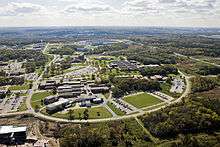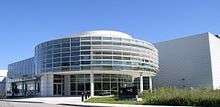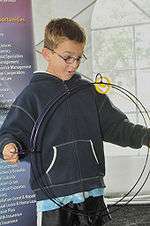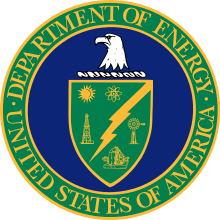Argonne National Laboratory
Argonne National Laboratory is a science and engineering research national laboratory operated by University of Chicago Argonne LLC for the United States Department of Energy. The facility is located in Lemont, Illinois, outside of Chicago, and is the largest national laboratory by size and scope in the Midwest.
| Established | 1946 |
|---|---|
| Research type | Research |
| Budget | $750 million (2017)[1] |
Field of research | Physical science Life science Environmental science Energy science Photon science Data science Computational science |
| Director | Paul Kearns |
| Staff | 3,350 |
| Address | 9700 S. Cass Avenue |
| Location | Lemont, Downers Grove Township, DuPage County, Illinois, USA |
| Campus | 1,700 acres (6.9 km2) |
| Affiliations | United States Department of Energy University of Chicago Jacobs Engineering |
| Enrico Fermi Maria Goeppert Mayer Alexei Alexeyevich Abrikosov | |
| Website | www.anl.gov |

Argonne was initially formed to carry out Enrico Fermi's work on nuclear reactors as part of the Manhattan Project. It was designated as the first national laboratory in the United States on July 1, 1946.[2] In the post-war era the lab focused primarily on non-weapon related nuclear physics, designing and building the first power-producing nuclear reactors, helping design the reactors used by the United States' nuclear navy, and a wide variety of similar projects. In 1994, the lab's nuclear mission ended, and today it maintains a broad portfolio in basic science research, energy storage and renewable energy, environmental sustainability, supercomputing, and national security.
UChicago Argonne, LLC, the operator of the laboratory, "brings together the expertise of the University of Chicago (the sole member of the LLC) with Jacobs Engineering Group Inc."[3] Argonne is a part of the expanding Illinois Technology and Research Corridor. Argonne formerly ran a smaller facility called Argonne National Laboratory-West (or simply Argonne-West) in Idaho next to the Idaho National Engineering and Environmental Laboratory. In 2005, the two Idaho-based laboratories merged to become the Idaho National Laboratory.[4]
Overview
Argonne has five main areas of focus. These goals, as stated by the DOE in 2008,[5] consist of:
- Conducting basic scientific research;
- Operating national scientific facilities;
- Enhancing the nation's energy resources;
- Developing better ways to manage environmental problems;
- Protecting national security.
History

What would become Argonne began in 1942 as the Metallurgical Laboratory at the University of Chicago, which had become part of the Manhattan Project. The Met Lab built Chicago Pile-1, the world's first nuclear reactor, under the stands of the University of Chicago sports stadium. Considered unsafe, in 1943, CP-1 was reconstructed as CP-2, in what is today known as Red Gate Woods but was then the Argonne Forest of the Cook County Forest Preserve District near Palos Hills. The lab was named after the surrounding forest, which in turn was named after the Forest of Argonne in France where U.S. troops fought in World War I.[6] Fermi's pile was originally going to be constructed in the Argonne forest, and construction plans were set in motion, but a labor dispute brought the project to a halt. Since speed was paramount, the project was moved to the squash court under Stagg Field, the football field on the campus of the University of Chicago. Fermi told them that he was sure of his calculations, which said that it would not lead to a runaway reaction, which would have contaminated the city.
Other activities were added to Argonne over the next five years. On July 1, 1946, the "Metallurgical Laboratory" was formally re-chartered as Argonne National Laboratory for "cooperative research in nucleonics." At the request of the U.S. Atomic Energy Commission, it began developing nuclear reactors for the nation's peaceful nuclear energy program. In the late 1940s and early 1950s, the laboratory moved to a larger location in unincorporated DuPage County, Illinois and established a remote location in Idaho, called "Argonne-West," to conduct further nuclear research.
In quick succession, the laboratory designed and built Chicago Pile 3 (1944), the world's first heavy-water moderated reactor, and the Experimental Breeder Reactor I (Chicago Pile 4), built-in Idaho, which lit a string of four light bulbs with the world's first nuclear-generated electricity in 1951. A complete list of the reactors designed and, in most cases, built and operated by Argonne can be viewed in the, "Reactors Designed by Argonne" page. The knowledge gained from the Argonne experiments conducted with these reactors 1) formed the foundation for the designs of most of the commercial reactors currently used throughout the world for electric power generation and 2) inform the current evolving designs of liquid-metal reactors for future commercial power stations.
Conducting classified research, the laboratory was heavily secured; all employees and visitors needed badges to pass a checkpoint, many of the buildings were classified, and the laboratory itself was fenced and guarded. Such alluring secrecy drew visitors both authorized—including King Leopold III of Belgium and Queen Frederica of Greece[7]—and unauthorized. Shortly past 1 a.m. on February 6, 1951, Argonne guards discovered reporter Paul Harvey near the 10-foot (3.0 m) perimeter fence, his coat tangled in the barbed wire. Searching his car, guards found a previously prepared four-page broadcast detailing the saga of his unauthorized entrance into a classified "hot zone". He was brought before a federal grand jury on charges of conspiracy to obtain information on national security and transmit it to the public, but was not indicted.[8]
Not all nuclear technology went into developing reactors, however. While designing a scanner for reactor fuel elements in 1957, Argonne physicist William Nelson Beck put his own arm inside the scanner and obtained one of the first ultrasound images of the human body.[9] Remote manipulators designed to handle radioactive materials laid the groundwork for more complex machines used to clean up contaminated areas, sealed laboratories or caves.[10] In 1964, the "Janus" reactor opened to study the effects of neutron radiation on biological life, providing research for guidelines on safe exposure levels for workers at power plants, laboratories and hospitals.[11] Scientists at Argonne pioneered a technique to analyze the moon's surface using alpha radiation, which launched aboard the Surveyor 5[12] in 1967 and later analyzed lunar samples from the Apollo 11 mission.
In addition to nuclear work, the laboratory maintained a strong presence in the basic research of physics and chemistry. In 1955, Argonne chemists co-discovered the elements einsteinium and fermium, elements 99 and 100 in the periodic table.[13] In 1962, laboratory chemists produced the first compound of the inert noble gas xenon, opening up a new field of chemical bonding research.[14] In 1963, they discovered the hydrated electron.[15]
High-energy physics made a leap forward when Argonne was chosen as the site of the 12.5 GeV Zero Gradient Synchrotron, a proton accelerator that opened in 1963. A bubble chamber allowed scientists to track the motions of subatomic particles as they zipped through the chamber; in 1970, they observed the neutrino in a hydrogen bubble chamber for the first time.[16]
Meanwhile, the laboratory was also helping to design the reactor for the world's first nuclear-powered submarine, the U.S.S. Nautilus, which steamed for more than 513,550 nautical miles (951,090 km). The next nuclear reactor model was Experimental Boiling Water Reactor, the forerunner of many modern nuclear plants, and Experimental Breeder Reactor II (EBR-II), which was sodium-cooled, and included a fuel recycling facility. EBR-II was later modified to test other reactor designs, including a fast-neutron reactor and, in 1982, the Integral Fast Reactor concept—a revolutionary design that reprocessed its own fuel, reduced its atomic waste and withstood safety tests of the same failures that triggered the Chernobyl and Three Mile Island disasters.[17] In 1994, however, the U.S. Congress terminated funding for the bulk of Argonne's nuclear programs.
Argonne moved to specialize in other areas, while capitalizing on its experience in physics, chemical sciences and metallurgy. In 1987, the laboratory was the first to successfully demonstrate a pioneering technique called plasma wakefield acceleration, which accelerates particles in much shorter distances than conventional accelerators.[18] It also cultivated a strong battery research program.
Following a major push by then-director Alan Schriesheim, the laboratory was chosen as the site of the Advanced Photon Source, a major X-ray facility which was completed in 1995 and produced the brightest X-rays in the world at the time of its construction.
On 19 March 2019, it was reported in the Chicago Tribune that the laboratory was constructing the world's most powerful supercomputer. Costing $500 million it will have the processing power of 1 quintillion flops. Applications will include the analysis of stars and improvements in the power grid.
Directors
Over the course of its history, 13 individuals have served as Argonne Director:
- 1946–1956 Walter Zinn
- 1957–1961 Norman Hilberry
- 1961–1967 Albert V. Crewe
- 1967–1973 Robert B. Duffield
- 1973–1979 Robert G. Sachs
- 1979–1984 Walter E. Massey
- 1984–1996 Alan Schriesheim
- 1996–1998 Dean E. Eastman
- 2000–2005 Hermann A. Grunder
- 2005–2008 Robert Rosner
- 2009–2014 Eric Isaacs
- 2014–2016 Peter Littlewood
- 2017–Present Paul Kearns[19]
Initiatives

- Hard X-ray Sciences: Argonne is home to one of the world's largest high-energy light sources: the Advanced Photon Source (APS). Each year, scientists make thousands of discoveries while using the APS to characterize both organic and inorganic materials and even processes, such as how vehicle fuel injectors spray gasoline in engines.[20]
- Leadership Computing: Argonne maintains one of the fastest computers for open science and has developed system software for these massive machines. Argonne works to drive the evolution of leadership computing from petascale to exascale, develop new codes and computing environments, and expand computational efforts to help solve scientific challenges. For example, in October 2009, the laboratory announced that it would be embarking on a joint project to explore cloud computing for scientific purposes.[21] In the 1970s Argonne translated the Numerische Mathematik numerical linear algebra programs from ALGOL to Fortran and this library was expanded into LINPACK and EISPACK, by Cleve Moler, et al.
- Materials for Energy: Argonne scientists work to predict, understand, and control where and how to place individual atoms and molecules to achieve desired material properties. Among other innovations, Argonne scientists helped develop an ice slurry to cool the organs of heart attack victims,[22] described what makes diamonds slippery at the nanoscale level,[23] and discovered a superinsulating material that resists the flow of electric current more completely than any other previous material.[24]
- Electrical Energy Storage: Argonne develops batteries for electric transportation technology and grid storage for intermittent energy sources like wind or solar, as well as the manufacturing processes needed for these materials-intensive systems. The laboratory has been working on advanced battery materials research and development for over 50 years.[25] In the past 10 years, the laboratory has focused on lithium-ion batteries, and in September 2009, it announced an initiative to explore and improve their capabilities.[26] Argonne also maintains an independent battery-testing facility, which tests sample batteries from both government and private industry to see how well they perform over time and under heat and cold stresses.[27]
- Alternative Energy and Efficiency: Argonne develops both chemical and biological fuels tailored for current engines as well as improved combustion schemes for future engine technologies. The laboratory has also recommended best practices for conserving fuel; for example, a study that recommended installing auxiliary cab heaters for trucks in lieu of idling the engine.[28] Meanwhile, the solar energy research program focuses on solar-fuel and solar-electric devices and systems that are scalable and economically competitive with fossil energy sources.[29] Argonne scientists also explore best practices for a smart grid, both by modeling power flow between utilities and homes and by researching the technology for interfaces.[30]
- Nuclear Energy: Argonne generates advanced reactor and fuel cycle technologies that enable the safe, sustainable generation of nuclear power. Argonne scientists develop and validate computational models and reactor simulations of future generation nuclear reactors.[31] Another project studies how to reprocess spent nuclear fuel, so that waste is reduced up to 90%.[32]
- Biological and Environmental Systems: Understanding the local effect of climate change requires integration of the interactions between the environment and human activities. Argonne scientists study these relationships from molecule to organism to ecosystem. Programs include bioremediation using trees to pull pollutants out of groundwater;[33] biochips to detect cancers earlier;[34] a project to target cancerous cells using nanoparticles;[35] soil metagenomics; and a major climate change research project, ARM.[36]
- National Security: Argonne develops security technologies that will prevent and mitigate events with potential for mass disruption or destruction. These include sensors that can detect chemical, biological, nuclear and explosive materials;[37] portable Terahertz radiation ("T-ray") machines that detect dangerous materials more easily than X-rays at airports;[38] and tracking and modeling the possible paths of chemicals released into a subway.[39]
User facilities and centers

Argonne builds and maintains scientific facilities that would be too expensive for a single company or university to construct and operate. These facilities are used by scientists from Argonne, private industry, academia, other national laboratories and international scientific organizations.
- Advanced Photon Source (APS): a national synchrotron X-ray research facility which produces the brightest X-ray beams in the Western Hemisphere.[40]
- Center for Nanoscale Materials (CNM): a user facility located on the APS which provides infrastructure and instruments to study nanotechnology and nanomaterials. The CNM is one of five U.S. Department of Energy Office of Science Nanoscale Science Research Centers.[41]
- Argonne Tandem Linac Accelerator System (ATLAS): ATLAS is the world's first superconducting particle accelerator for heavy ions at energies in the vicinity of the Coulomb barrier. This is the energy domain suited to study the properties of the nucleus, the core of matter and the fuel of stars.[42]
- Electron Microscopy Center (EMC): one of three DOE-supported scientific user facilities for electron beam microcharacterization. The EMC conducts in situ studies of transformations and defect processes, ion beam modification and irradiation effects, superconductors, ferroelectrics and interfaces. Its intermediate voltage electron microscope, which is coupled with an accelerator, represents the only such system in the United States.[43]
- Argonne Leadership Computing Facility (ALCF): a DOE Office of Science User Facility that provides supercomputing resources to the research community to enable breakthroughs in science and engineering.
- Structural Biology Center (SBC): The SBC is a user facility located off the Advanced Photon Source X-ray facility, which specializes in macromolecular crystallography. Users have access to an insertion-device, a bending-magnet, and a biochemistry laboratory. SBC beamlines are often used to map out the crystal structures of proteins; in the past, users have imaged proteins from anthrax, meningitis-causing bacteria, salmonella, and other pathogenic bacteria.[44]
- Transportation Research & Analysis Computing Center (TRACC): a facility which uses high-performance computing to analyze and create data and visual models for a variety of transportation issues, including crashworthiness, aerodynamics, combustion, thermal management, weather modeling and traffic simulation.[45]
- Atmospheric Radiation Measurement Climate Research Facility (ARM): Argonne is one of nine national laboratories which contribute to the ARM program, designed to research global climate change. Argonne oversees ARM operations and manages a meteorological data-gathering site in Oklahoma and a mobile data-gathering facility.[46]
- The Network Enabled Optimization System (NEOS) Server is the first network-enabled problem-solving environment for a wide class of applications in business, science, and engineering. Included are state-of-the-art solvers in integer programming, nonlinear optimization, linear programming, stochastic programming, and complemetarity problems. Most NEOS solvers accept input in the AMPL modeling language.
- The Joint Center for Energy Storage Research (JCESR) is a consortium of several national laboratories, academic institutions, and industrial partners based at Argonne National Laboratory. The mission of JCESR is to design and build transformative materials enabling next-generation batteries that satisfy all the performance metrics for a given application.[47][48]
- The Midwest Integrated Center for Computational Materials (MICCoM) is headquartered at the laboratory. MICCoM develops and disseminates interoperable open-source software, data, and validation procedures to simulate and predict properties of functional materials for energy conversion processes.[49][50]
Educational and community outreach

Argonne welcomes all members of the public age 16 or older to take guided tours of the scientific and engineering facilities and grounds. For children under 16, Argonne offers hands-on learning activities suitable for K–12 field trips and scout outings. The laboratory also hosts educational science and engineering outreach for schools in the surrounding area.
Argonne scientists and engineers take part in the training of nearly 1,000 college graduate students and post-doctoral researchers every year as part of their research and development activities.
In media
Significant portions of the 1996 chase film Chain Reaction were shot in the Zero Gradient Synchrotron ring room and the former Continuous Wave Deuterium Demonstrator laboratory.[51]
Notable staff
- Alexei Alexeyevich Abrikosov
- Margaret K. Butler
- Ian Foster
- Wallace Givens
- Raymond Goertz
- Morton Hamermesh
- Caroline Herzenberg
- William McCune
- Maria Goeppert Mayer
- Carlo Montemagno
- José Enrique Moyal
- Gilbert Jerome Perlow
- Aneesur Rahman
- Kameshwar C. Wali
- Larry Wos
- Cosmas Zachos
- Daniel Zajfman
- Nestor J. Zaluzec
- Paul Fenter
- Lynda Soderholm
- Rick Stevens
- Valerie Taylor
See also
- Advanced Research Projects Agency-Energy
- Automated theorem proving
- Canadian Penning Trap Spectrometer
- Center for the Advancement of Science in Space—operates the US National Laboratory on the ISS.
- Gammasphere
- Nanofluid
- Track Imaging Cherenkov Experiment
Notes
- "Argonne: By the Numbers". Argonne National Laboratory. 2017. Retrieved 5 September 2018.
- Holl, Hewlett, and Harris, page xx (Introduction).
- "World-class Scientific Research & Innovation". UChicago Argonne, LLC. Retrieved 2012-12-18.
- Menser, Paul. "Cleaning house and charting a future at INL". Post Register. Idaho Falls, ID. Archived from the original on 2013-11-13.
- "Argonne National Laboratory". U.S. Department of Energy. Archived from the original on 2010-05-27. Retrieved 2009-12-14.
- "Argonne: History". Argonne National Laboratory. Retrieved 12 February 2017.
- "Argonne Highlights: 1950–1959". Argonne National Laboratory. Archived from the original on 2012-02-04. Retrieved 2010-02-04.
- Stephens, Joel (2010-01-23). "New documents show longtime friendship between J. Edgar Hoover and Paul Harvey". Washington Post.
- "William Nelson "Nels" Beck: Joliet Physicist's Work Changed Medical World". CityofJoliet.com.
- Holl, Hewlett, and Harris, page 126
- "Research helps safeguard nuclear workers worldwide". Argonne National Laboratory.
- Jacobsen, Sally (December 1971). "Getting Aboard Viking: No Room on the Mars Lander".
- Holl, Hewlett, and Harris, page 179.
- Holl, Hewlett, and Harris, page 226.
- "Argonne History: Innovation and Serendipity". Argonne National Laboratory. Archived from the original on 2010-05-27. Retrieved 2010-02-04.
- Patel, page 23
- "Frontline: Nuclear Reaction: Interview with Dr. Charles Till". PBS.
- "Argonne History: Understanding the Physical Universe". Argonne National Laboratory. Archived from the original on 9 September 2004.
- "Paul K. Kearns | Argonne National Laboratory". www.anl.gov. Retrieved 2019-02-26.
- "New X-ray technique may lead to better, cleaner fuel injectors for automobiles". Argonne National Laboratory. 2008-02-19.
- "DOE to explore scientific cloud computing at Argonne, Lawrence Berkeley national laboratories". Argonne National Laboratory. 2009-10-14.
- Gupta, Manya (2009-11-10). "Medical care on ice". Medill Reports. Archived from the original on 2011-09-30.
- University of Pennsylvania (25 June 2008). "Engineers reveal what makes diamonds slippery at the nanoscale". ScienceDaily.
- "Newly discovered 'superinsulators' promise to transform materials research, electronics design". Argonne National Laboratory. 2008-04-04. Archived from the original on 2009-08-26.
- "Building better batteries". U.S. Department of Energy. Archived from the original on 2010-05-27. Retrieved 2009-12-13.
- "Argonne opens new chapter in battery research: Li-Air". Argonne National Laboratory. 2009-09-15.
- "Battery Test Facility". Argonne National Laboratory, Transportation Center. Retrieved 2009-12-13.
- Leavitt, Wendy (1998-08-01). "Not Just Idle Talk". Fleet Owner.
- "Argonne, Northwestern seek ANSER to solar energy challenges". Argonne National Laboratory. 2007-05-08.
- "Grid Research: Making the Grid Smarter". Argonne National Laboratory Transportation Center. 2009-08-01.
- "Putting the new in nuclear". Argonne National Laboratory magazine. Fall 2009.
- "Doing the impossible: Recycling nuclear waste". Science Channel. Retrieved 2013-06-10.
- "Argonne Cleans Up Brownfield Sites [video]". CleanSkies Network. 2009-11-10. Archived from the original on 2009-12-21.
- "Biochips can detect cancers before symptoms develop". Argonne National Laboratory. 2008-05-09.
- Wang, Ann (2 December 2009). "Magnetic microdiscs target and initiate cell death in tumors". Johns Hopkins Newsletter.
- "ARRA funding to help scientists better understand climate change". Argonne National Laboratory. 2009-12-08.
- "New sensor technology detects chemical, biological, nuclear and explosive materials". Argonne National Laboratory. 2006-03-21.
- "New T-ray source could improve airport security, cancer detection". Argonne National Laboratory. 2007-11-23.
- Szaniszlo, Marie (2009-12-06). "MBTA preps for biological terror attack". Boston Herald.
- Argonne About the APS Archived 2009-09-26 at the Wayback Machine
- Department of Energy Nanoscale Science Research Centers Archived 2009-12-08 at the Wayback Machine
- "Argonne Physics Division – ATLAS". www.phy.anl.gov. Retrieved 20 June 2018.
- "About the EMC". Archived from the original on 6 September 2017. Retrieved 20 June 2018.
- "MCSG Deposit Their 1,000th Protein Structure into Protein Data Bank". AZoNano.com. 27 July 2009. Retrieved 20 June 2018.
- "About TRACC". Retrieved 20 June 2018.
- "ARM Research Facility". www.arm.gov. Retrieved 20 June 2018.
- "Joint Center for Energy Storage Research Publication List". www.jcesr.org/publications/published-papers.
- "Joint Center for Energy Storage Research". www.jcesr.org. Retrieved 20 June 2018.
- "DOE creates new Center for Computational Materials at Argonne". Retrieved 28 January 2019.
- "MICCoM Mission". Retrieved 28 January 2019.
- "Argonne Basks In Attention Of Anniversary, Film". Retrieved 20 June 2018.
References
- Argonne National Laboratory, 1946–96. Jack M. Holl, Richard G. Hewlett, Ruth R. Harris. University of Illinois Press, 1997. ISBN 978-0-252-02341-5.
- Nuclear physics: an introduction. S.B. Patel. New Age International Ltd., 1991. ISBN 81-224-0125-2.
- Summary of Nuclear Chemistry Work at Argonne, Martin H. Studier, Argonne National Laboratory Report, Declassified June 13, 1949.
External links
| Wikimedia Commons has media related to Argonne National Laboratory. |
- Argonne National Laboratory—Official Argonne website
- Argonne National Laboratory Presentations—Finding aid for Argonne National Laboratory presentations
- Argonne News—News releases, media center
- Argonne Software Shop—Open source and commercially available software in or near the "shrink-wrap" phase
- Photo repository—Photography for public use

